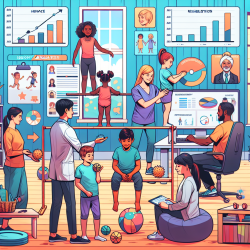Introduction
In the realm of speech-language pathology and online therapy, understanding the diverse needs of the populations we serve is crucial for effective intervention. A recent study titled Analysis of Reported Health Care Use by Sexual Orientation Among Youth sheds light on the disparities faced by lesbian, gay, and bisexual (LGB) youth in accessing health care. This blog post will explore how practitioners can enhance their clinical skills and improve outcomes for LGB youth by integrating the findings from this study into their practice.
Understanding the Disparities
The study, conducted on a cohort of 4,256 diverse 10th graders, revealed significant disparities in health care utilization between LGB and non-LGB youth. Notably, LGB youth were found to have a higher likelihood of not receiving needed medical care, particularly for issues related to sexually transmitted infections, contraception, and substance use. Additionally, LGB youth reported more difficulty in communicating with health care providers, indicating a critical gap in clinician-patient interactions.
Implications for Practitioners
For practitioners working with LGB youth, these findings highlight the importance of creating an inclusive and supportive clinical environment. Here are some actionable steps practitioners can take:
- Enhance Communication Skills: Practitioners should focus on developing open communication channels with LGB youth. This includes actively listening, being non-judgmental, and ensuring confidentiality to build trust.
- Educate on Sexual Orientation: Understanding the unique challenges faced by LGB youth is crucial. Practitioners should educate themselves on the cultural and social factors affecting LGB youth's health care experiences.
- Implement Inclusive Practices: Incorporating inclusive language and practices in therapy sessions can make LGB youth feel more comfortable and understood.
- Advocate for Training: Advocate for training programs that focus on the specific needs of LGB youth, ensuring that all staff members are equipped to provide culturally competent care.
Encouraging Further Research
While this study provides valuable insights, there is a need for further research to explore the underlying causes of these disparities and develop targeted interventions. Practitioners are encouraged to engage in research initiatives that focus on improving health care access and outcomes for LGB youth.
Conclusion
By integrating the findings from the Analysis of Reported Health Care Use by Sexual Orientation Among Youth study into their practice, practitioners can play a pivotal role in reducing health care disparities and improving the overall well-being of LGB youth. It is imperative that we continue to strive for inclusivity and equity in health care to ensure that all children receive the support they need to thrive.










